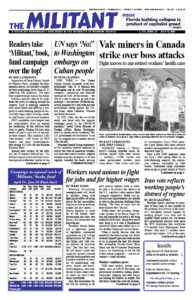Actions around the country celebrated Juneteenth, which only became a federal holiday two days earlier. June 19 marks an important milestone in the Second American Revolution, which abolished slavery and led to the strengthening of the working class with millions of freed Blacks.
After the Civil War ended in the summer of 1865, Union General Gordon Granger and his troops traveled to Galveston, Texas, and on June 19, 1865, he issued General Order No. 3.
It said: “The people are informed that, accordance with a proclamation from the Executive of the United States, all slaves are free. This involves an absolute equality of personal rights and rights of property, between former masters and slaves, and the connection heretofore existing between them, becomes that between employer and hired labor. The Freedmen are advised to remain at their present homes, and work for wages. They are informed that they will not be allowed to collect at military posts; and that they will not be supported in idleness either there or elsewhere.”
There were still 250,000 people enslaved in Texas, the last state of the Confederacy. This was over two years after President Abraham Lincoln had issued the Emancipation Proclamation. Not until December 1865 was the 13th Amendment to the U.S. Constitution ratified, which abolished slavery throughout the entire country.
Granger’s order recognized the new class relations established by these revolutionary measures — with capitalist “free-labor” replacing the slave system. This helped lead to a rapid expansion of capitalist production across the country and consequently of struggles waged by working people.
After the end of the war, Radical Reconstruction was adopted, led by the most resolute opponents of slavery. This deepened the changes made possible by the overthrow of chattel slavery. With the passage of the 14th Amendment in 1868 freed slaves won U.S. citizenship. African Americans won the right to vote when the 15th Amendment was ratified in 1870.
The former slaves sought to advance their rights and demanded their own land and tools to farm, forging alliances with exploited farmers and other toilers in the South who were white. Their slogan was 40 acres and a mule. Small farmers and propertyless rural working people made up the big majority of the population in all the former Confederate states. In five states Blacks were a majority.
By 1867 Radical Reconstruction regimes, many led by Blacks, had been set up throughout the South, backed by the power of the Union army. These governments fought for implementation of Black rights and immediate and democratic demands in the interests of all working people. This included the first free public schools in the South, public hospitals and medical care for the poor, barring of racial discrimination, and expansion of a woman’s right to obtain a divorce.
The capitalist rulers, fearing this growing class alliance, withdrew Union troops from the South in 1877, accelerating a reign of terror by the Ku Klux Klan and other racist gangs. This bloody defeat of Radical Reconstruction, leading over decades of battle to the imposition of Jim Crow segregation, was the worst setback not only for Blacks but also for the entire working class.
Railroad strikes in 1877
A huge strike wave erupted that same year leading many workers to become more aware of their common interests as a class. Railroad workers walked out in response to wage cuts by the bosses in the midst of a prolonged economic depression. The entire U.S. rail system was rapidly shut down, and large numbers of workers in other industries went on strike in solidarity.
Commenting on the importance of this “Great Strike,” Karl Marx, in a July 25, 1877, letter to Frederick Engels, wrote: “What do you think of the workers in the United States? This first eruption against the oligarchy of associated capital which has arisen since the Civil War will of course be put down, but it could quite well form the starting point for the establishment of a serious labour party in the United States.”
Marx explained the decision of the capitalist rulers to withdraw Union troops “will turn the Negroes into allies of the workers, and the large expropriations of land (especially fertile land) in favour of railway, mining, etc., companies will convert the farmers of the West, who are already very disenchanted, into allies of the workers.”
However, the growing economic and political strength of a rising capitalist class and lack of class struggle experience and leadership of the working class meant this didn’t occur. “Nonetheless, Marx could not have been more correct,” wrote Jack Barnes, national secretary of the Socialist Workers Party, in Malcolm X, Black Liberation, and the Road to Workers Power, “about the alliance of social forces that would have to be at the center of a successful revolution in the United States — the working class, toilers who are Black, and exploited farmers.”
These are some of the monumental consequences of the overthrow of the slave system in the U.S. that is marked by Juneteenth.

